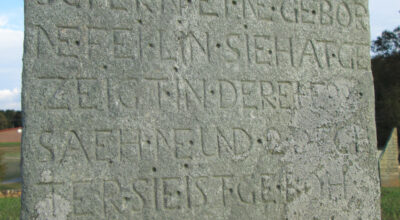A little later, and a little further back
Published 12:00 am Monday, August 18, 2014
We sometimes hear about the dangers of giving birth after age 30. A listing of the peril to both mother and baby usually follows, but I won’t do that here; you can “Google” it.
I was a “late edition” as far as my mother’s age at my birth in 1951 is concerned; but even then, I wasn’t quite “done”( a little premature). She was 40 and my father was 45 (people are advised nowadays to not make information about themselves or their family public, but it’s a little late for that).
My father was born in 1906, when Theodore Roosevelt was in the White House, and my mother in 1911, while Taft was president. Concerning those particular presidential administrations, Joseph of the Bible might have foreseen them in a dream as: “Eight robust years, followed by four years of ‘rotundity.��� ”.
During my early life, rock ‘n’ roll was also new, along with transistor radios, Sputnik, UFOs and UFO- inspired movies.
I also heard stories from my parents. Due to the “lateness” of my arrival in their lives, these stories leaped back two generations ( kind of like reverse, generational hopscotch).
There were recountings of the times of the 1920s and 30s. Because my father loved the music of those days (and all kinds of music) he played jazz LPs of it while I was growing up. As a result , an assortment of “background music” from times earlier than mine sometimes mentally accompanies my memories.
I was told of mobsters, the Charleston, the Tango, Caruso, silent movie stars such as Ramon Navarro, Rudolph Valentino and the Varsity Drag (not attire-related).
My mother told me about their attending a “Fats Waller” concert. I also received instruction concerning “Kay Kyser’s College of Musical Knowledge.” I grew up liking Bing Crosby and respecting what people went through during the Great Depression and World War II. To me, the great “hymn” of the Great Depression is “Brother, Can You Spare a Dime?” as performed by Crosby. In a much lighter vein, I always enjoyed Groucho Marx’s “ethereal tenor” intonation of Gilbert and Sullivan’s “Tit-willow” song.
When I saw “The Werewolf of London” (starring Henry Hull, also of “Lifeboat” fame) on television’s old “Shock Theater” in the early 1960s, my mother told me about her and my father seeing it at a Statesville theater in the 1930s. After the movie let out, they were walking with some friends. One friend stealthily concealed himself behind a bush, then jumped out at the group, presenting them with the frightening prospect of “The Werewolf of Statesville!”
My mother told me of the time she and my father were paying their respects at a funeral home in the 1930s. She said both of them, especially my father, couldn’t get over the “spitting-image” resemblance of someone there to Boris Karloff (a fellow mourner, not the corpse).
Speaking of doubles, they say everyone has at least one; and I saw mine in an old German newsreel which was part of a World War II documentary (he was just a regular German soldier, not “the guy” making the speech).
My brother Joe told me our mother took him to see the Robert Alda, Peter Lorre movie “The Beast With Five Fingers” when it was released in 1947 when he was approaching 6 years of age. Joe added that after seeing it, he had nightmares for a month. Our father took him to see “The Thing From Another World” in 1951. The same year, my big brother probably felt that another “thing” had arrived, specifically in the Williams home on the Old Concord Road. (Well, 10 years, 1941-1951, is a nice-sized gap too, between brothers, sort of like having “two only-children.”)
My mother’s additional information on those later run “Late Movie” and “Shock Theater” films helped me visualize what it must have been like when that celluloid and my parents were in their prime.
Some people would see the amount of time separating my birth from that of my parents as a “double generation gap.” I don’t see it as an extra amount of empty space, but instead, a connection to an earlier time.
And by the way, there’s nothing much cooler than “Rhapsody in Blue,” the “Benny Goodman 1938 Carnegie Hall Concert” and that final song and dance number from “42nd Street (1933),” featuring Ruby Keeler.


